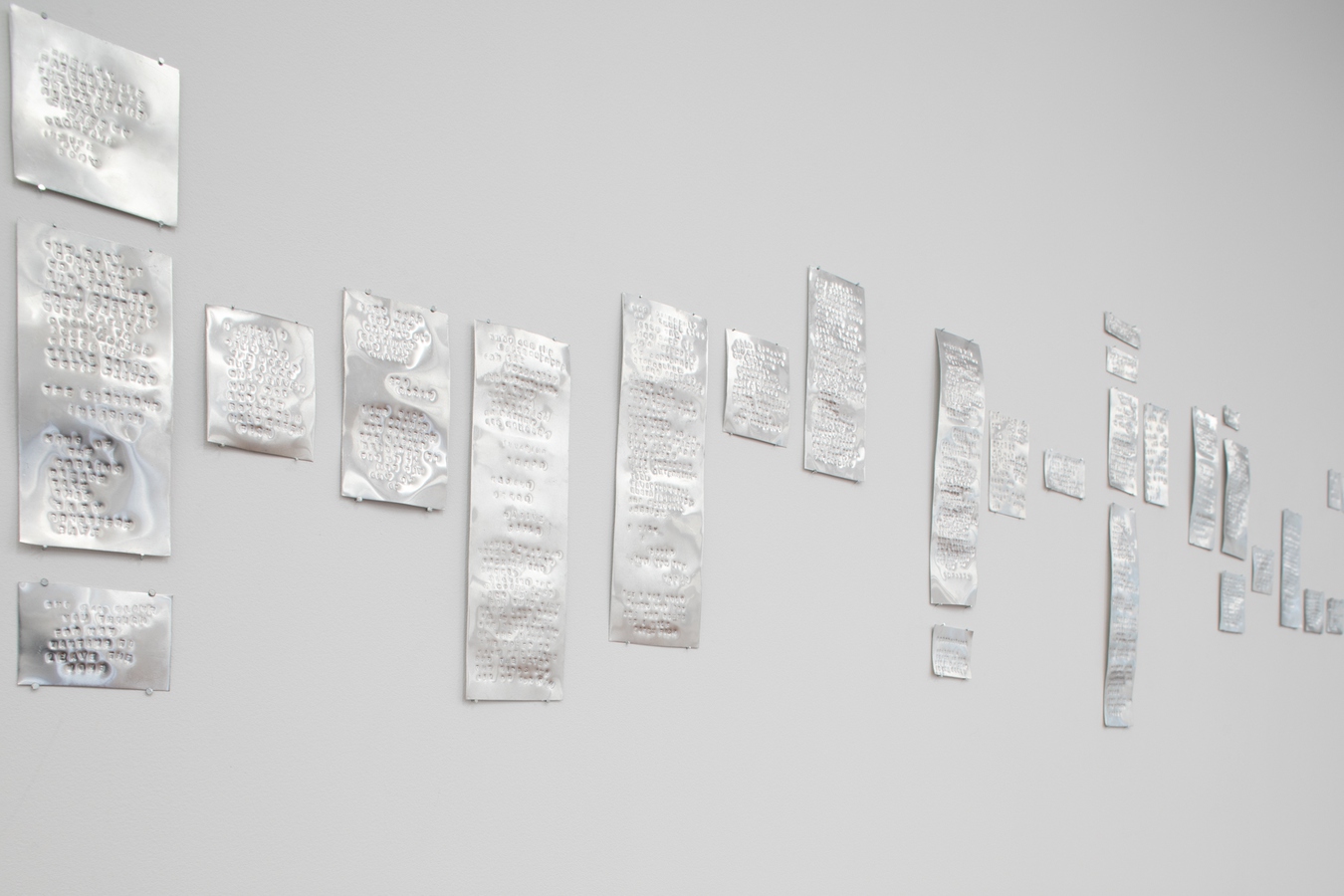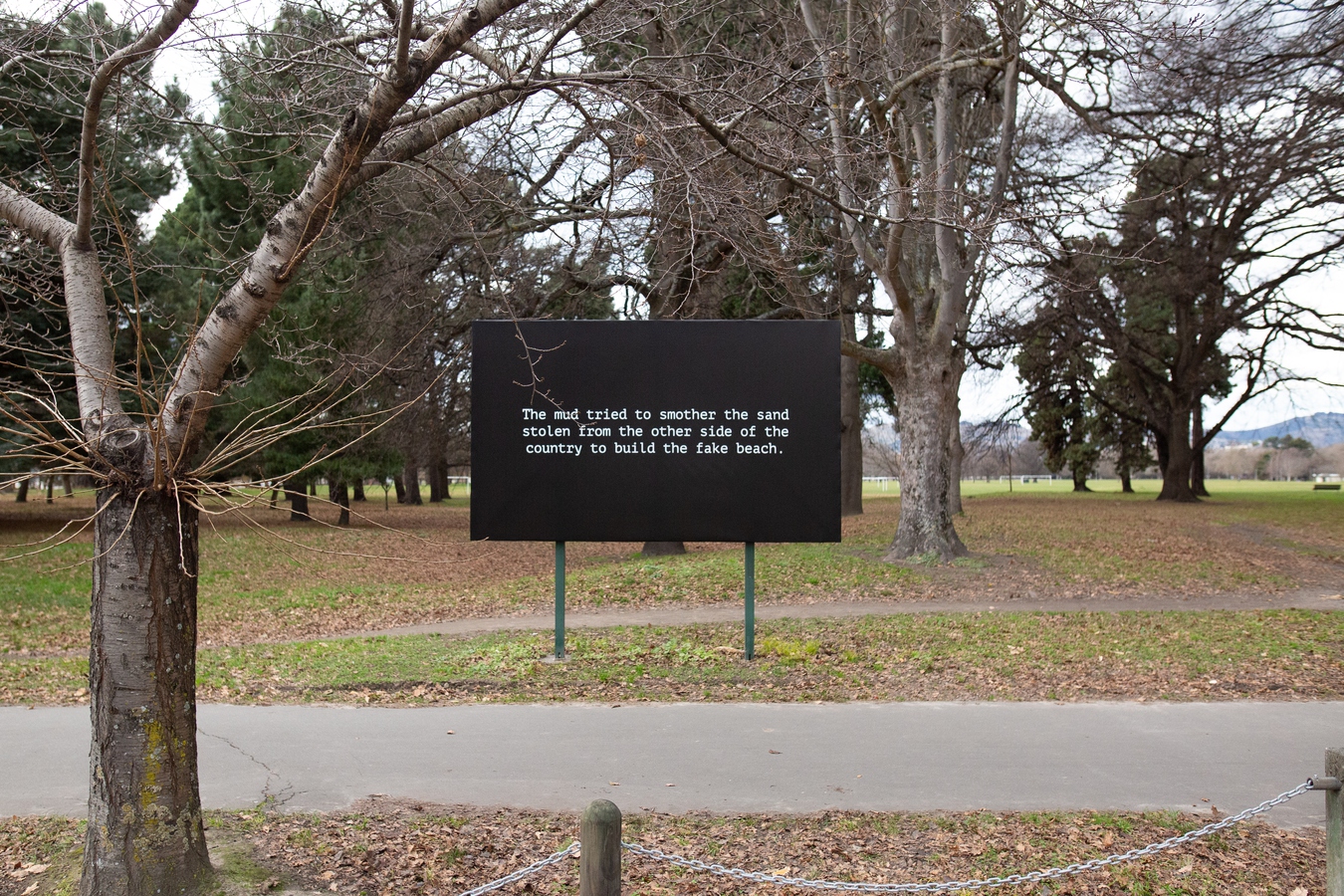Hana Pera Aoake, Wesley John Fourie, Taarn Scott
Invasive weeds
23 Jun — 31 Jul 2022
Invasive weeds or I wish I could give you the world, but I was only given mud, rot and the bones of a half-eaten fish.
Hana Pera Aoake, Wesley John Fourie, Taarn Scott
Curated by Abby Cunnane
Exhibition runs 23 June - 31 July 2022
Artist talk: Thursday 23 June, 4:30pm
Exhibition preview: Thursday 23 June, 5:30pm
This installation began as a piece of writing by Hana Pera Aoake. In Aoake’s text, written for their then-7-week-old baby, the swamp that lies beneath present-day Christchurch city is addressed as a site which remembers, hears, knows, mourns, and rages. Drawing on these ideas, Wesley, Taarn and Hana have collaboratively developed work in relation to the water that is held in the earth, and with a particular focus on the Ōtākaro awa which runs through this city. Conventionally, water in a gallery may be considered dangerous, compromising the materials that it protects. In Invasive weeds water is the primary element, vital to weeds and celebrated plants alike.
The gallery is divided by a thick curtain made of muka from harakeke harvested at Taarn’s dad’s farm in Signal Hill, and prepared together during wānanga. To enter, you must go through this work: a thick fringe of muka that brushes you, drawing attention to your skin, hair, and body. Inside the space, glinting pieces of tin are hammered to the walls. Each holds a fragment of Aoake’s writing. They are small, the scale of sardine tins or of kōkapu, the dappled native fish that travel our waterways. You need to be close to read the text; when you do, you’ll recognise the hours of tapping through which the words were pressed into them by Scott. Two south-facing windows in the building’s exterior have been revealed for this installation. At this time of the year, Matariki, when the day is the shortest, light floods like water into the room for about 8 hours. At night, the moons cast other forms of light as they transform through the month.
Rocks collected by the artists on their drive up from Ōtepoti to Ōtautahi are placed across the mataī floor, recording that trip and anchoring the installation for its duration, after which they’ll be returned to the sites where they were found. Ceramic bowls of water made by the artists are placed throughout the gallery, and visitors are encouraged to wash their hands and splash water over the rocks, which take on the onyx sleekness of tuna skin. For a moment, while they are wet, tuna are in the room. Ngāi Tūāhuriri kaumatua Taare Teone Tikao writes of the historical abundance of tuna in the area, “When the great eel migrations (heke-tuna) were on you could catch them…sometimes eels could be scooped out in thousands” (Tikao Talks, Reed, 1939). In many ways this installation is about acknowledging what is already here, always here in Te Waipounamu, rather than bringing new material into the gallery.
Beyond the gallery, six billboards containing lines from the Invasive weeds text are temporarily placed around North Hagley Park: you can view these while driving or walking along Harper Avenue. There are also digital billboards across three major streets in the central city: The Crossing Airbridge, Moorhouse Avenue (inbound) and Colombo St flyover (that goes over Moorhouse Avenue). These allow the walker, cyclist, driver, to experience the project as they navigate the city. Each text is a simple assertion of the presence of the land within and before and beyond that of the concreted city. Leaving The Physics Room, you can walk a ten-minute route to the North Hagley Park billboards, which will be in place for the first ten days of the exhibition.
In this and other recent works, such as Te Tamaiti, Te Ao, 2022 (currently showing at Artspace Aotearoa, Tāmaki Makaurau, until 6 August) Aoake reflects on what is possible, powerful, and fear-inducing in the arrival of a new child to the planet: “…I wish I could give you the world, but I was only given mud, rot and the bones of a half-eaten fish”. Intermittently, a song recorded from when the artists were making the work plays in the space. Its purpose is to offer a brief respite from anxiety, or even, a sense of hope. Water, and sleep, are processes of healing.
--
Hana Pera Aoake (Ngaati Mahuta, Ngaati Hinerangi me Ngaati Raukawa, Tainui/Waikato, Ngaati Waewae, Waitaha) is a māmā, artist and researcher based in Te Rotopaateke, Te Wai Pounamu. Their work explores tensions between Indigenous and European epistemologies, threading these together to weave new meanings. They hold an MFA (first class honours) from Massey University Te Kunenga Ki Pūrehuroa (2018) and took part in the ISP programme at Maumaus des escola artes (2020). Aoake co-organises Kei te pai press with Morgan Godfrey, and recently published A bathful of hot water and kawakawa (Compound Press, 2021). They were also a participant in the Regional Arts Australia programme (2021-22).
Wesley John Fourie is currently based in Tāmaki Makaurau. They work primarily with textiles, making large soft sculptures that concern ideas of spirituality, queer sexuality, loss, and the environment. They also write, make performance, draw and paint. Recent solo exhibitions include i followed you into the sea at Te Kōputu, Te Whanga a Toi Whakatane; The Dance, Window Gallery, University of Auckland, Tāmaki Makaurau; and I dream a rainforest, Malcolm Smith Gallery, Tāmaki Makaurau. Recent collaborative projects with Hana Pera Aoake and Taarn Scott include The Future of Dirt at RM Gallery, Tāmaki Makaurau and An Endless Sky of Honey at Meanwhile, Te Whanganui-a-Tara, both 2022.
Taarn Scott is an artist from Ōtepoti. She graduated from Elam School of Fine arts with a BFA (honours), in 2019. Scott is interested in illustrative practices, community art, and the tactile. Recent exhibitions include Outlining/ Shifting Channels at Refinery ArtSpace, Whakatū Nelson; The Future of Dirt at RM Gallery, Tāmaki Makaurau, and An Endless Sky of Honey at Meanwhile, Te Whanganui-a-Tara (with Hana Pera Aoake and Wesley John Fourie), all 2022.
With thanks to Go Media, Ōtautahi, for their support of the digital billboards in this project.























